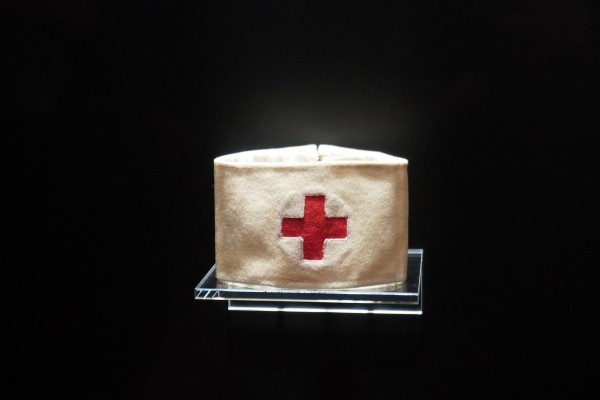Ontario hospitals looked to make themselves ‘lean’ throughout the pandemic
For nearly the entire history of medicare, the ‘public’ system has been run just like the private sector

Grand River Hospital in Kitchener, Ontario. Photo by Nick Matthews/Flickr.
Even as hospitals across Ontario were overwhelmed by patients during the pandemic—extending wait times and triggering triage protocols—the system’s managers were reportedly busy looking for “cost-savings.”
And while the crisis has been used by the Doug Ford government to further privatize the system, there is further evidence that the health system’s public sector managers have spent years wrecking it from inside.
System in crisis
Since 2020, Ontario’s health care system has lurched from crisis to crisis. Ontario’s hospital managers and the province’s right-wing government have worked, throughout this time, to privatize the system accordingly.
To recount, as recently as January, an Environics poll found that 80 percent of respondents believed the province’s health care system was in crisis—as influxes of patients overwhelmed long short-staffed and under-resourced facilities, including children’s hospitals like Toronto’s Hospital for Sick Children (SickKids). Across the province, nurse-patient-ratios rose to a shocking 1:8 in ICUs, while emergency departments struggled to even stay open.
In response, as is well known, the Ford government announced new plans to move public procedures out of hospitals and into private and for-profit Independent Health Facilities. Listing all the procedures he plans to privatize, Ford told one press conference: “You add ‘em all up, what I understand is that’s 50 percent of the surgeries.”
Elsewhere, the Ford government cut funding for any “medically necessary physician and hospital services,” that would otherwise not be insured—especially those without residency status and foreign workers between contracts.
Ford’s claim essentially is that the system was and is unable to handle its patient volume and, accordingly, changes must be made to offload the system.
But an analysis of Ontario hospital human resources policies by PressProgress found that many hospitals in the province continued to use “lean” health care management systems—even throughout the pandemic.
Ford’s schemes, we’re told, are essential to clear up the backlog. But, for some reason, ending the system’s push for cuts was off the table.
‘Agile’ hospitals
Modeled on Taylorist innovations and work methods introduced on Toyota’s assembly lines in Japan, “lean” HR policies aim to save money and speed up the pace of work via the use of timing schemes, scorecards, “material cost” audits and the like. Since its first identified application in the Virginia Mason Medical Center, Lean has been pushed by right-wing governments across the world to burn out workers—often with the support of health care employers.
HR groups call lean an “agile management approach,” to speed up the pace of work. “Lean,” helped US auto bosses to track their workers—by the second. With it, they found that the average worker toiled for 45 seconds out of every minute. It, in turn, helped them increase that to 58 seconds.
As the Federal Reserve Bank of Chicago noted in a 1993 study: “In the early 1950s, Toyota discovered that a smaller number of workers, each capable of doing multiple tasks, could turn out cars using less inventory, less investment, and committing fewer mistakes. Accordingly, under lean or just-in-time manufacturing, tasks are performed by teams in which each member can do any of the team’s tasks, including maintenance, inspection, and machine setup.”
Overall, the study stressed that lean sought “speedy response to market conditions.”
Similarly, in health settings, Leading Lean: A Canadian Healthcare Leader’s Guide markets the system as follows:
We can imagine that patients of the future will enter into a specific value stream (e.g. medicine-short stay, surgery-long stay). The hospital will add value at every step of the way, from entrance to discharge, and every staff member will be empowered to eliminate any wasteful activity. This cross-functional approach to delivering value is how Toyota builds cars and beats its competitors—in quality, product development time and profit. It also provides insights into how we can face our current challenges in health care: remove waste to improve the quality of patient care and increase the number of patients we serve, all while reducing costs and the time patients wait.
‘Lean’ hospitals in Ontario
Starting with Toronto’s University Health Network, North York General Hospital and Windsor’s Hotel-Dieu Grace, a 2017 3M report notes that the program was embraced by Ontario’s Liberal government after the Great Recession of 2008.
Then, the McGuinty and Wynne Liberals were known to brag that Ontario had the “lowest program spending” per capita in Canada. The Liberals further vowed to scrap any budgetary line item that did not prove itself to be “relevant, effective, efficient, and sustainable.” Alongside a pay freeze for public sector workers, the province also froze base funding for hospitals and promoted new measures to cut costs.
By 2018, at the end of the Liberals’ reign, the province’s Financial Accountability Office (FAO) noted, health spending increases lagged behind the system’s core cost drivers—the latter averaging 4.3 percent annually. While, from 2005-06 to 2011-12, the province had been increasing health funding by 5.9 percent per year, from 2011-12 and 2015-16 that was cut to an average of 2.4 percent per year. As the FAO concluded: “Since 2012, health-sector spending has not kept pace with the funding pressure from inflation and Ontario’s growing and aging population, what the FAO calls the core cost drivers for health care.”
In 2009, Health Quality Ontario (HQO), the province’s health care advisory body, advised the City of Toronto to implement lean management in its long-term care homes, “to achieve the best possible processes and outcomes by encouraging the adoption of formal QI methodologies and skills.”
As the notice observes: “As a pilot project, OHQC proposed to introduce LEAN methodology and KAIZEN events into long-term care homes and assess their practicality and success in the long-term care homes system.”
A 2013 document from HQO promoted lean as a “solution,” to the health system’s “customer needs,” and as a way to guarantee the “Reduction or elimination of defects” and a “focus” on “value-added activities.”
This was also operationalized by Ontario’s hospital managers.
In 2009, the Ontario Hospital Association (OHA), in collaboration with consultants like KPMG, MoreSteam and the Leading Edge Group, began offering Ontario hospital managers online courses in “Lean Healthcare.” According to its brochure, these covered: “How to lead an organization so it meets its fiscal constraints.”
Caricaturing lean’s origins in Japanese factories, the OHA offered Ontario hospital managers “white belts,” “yellow belts” and “black belts,” in health care cost-cutting.
Around the same time, lean was also introduced in Saskatchewan. It, importantly, meant hospital managers following nurses around wards with stopwatches and filling out “time observation forms”—tracking their every movement—from turning around (max one second) to checking supply rooms (max three seconds).
Ontario Premier Doug Ford. Photo from Flickr.
Cost-cutting today
The OHA reportedly stopped offering its training workshops some years ago. A spokesperson told PressProgress it “evolved away from direct skills-based training and towards advancing leadership development within the hospital system.”
But other health facilities have continued to apply it.
According to hospital administrators contacted by PressProgress, many hospitals across Ontario say they are still using lean management practices to track the productivity of health workers.
Toronto’s SickKids reportedly counts itself as one hospital that uses lean. A spokesperson said the hospital “deployed a customized Lean Management System known as the ‘Daily Continuous Improvement Program (DailyCIP)’ to over 60 clinical and non-clinical teams across the organization.”
“Our dedicated Process Improvement team offers two levels of Lean training for SickKids staff,” the spokesperson added, “coaching is done in-house by members of the Process Improvement team.” These “coaches,” the spokesperson said, are trained in lean processes and are designated “Six-Sigma Master Black Belts.”
In nearby Mississauga, paramedics across the Trillium Health Network reported that emergency departments were so crowded, they could not meet standard “critical response times,” owing to its “capacity pressures.”
Yet, the same facility complaining about “capacity pressures” was actively tasking its HR department with cutting its hospital “capacity.” A spokesperson for Trillium said: “A number of staff at Trillium Health Partners (THP) are trained in Lean methodology and work in various departments across the hospital. Lean skills and associated tools are applied as part of our ongoing improvement activities and projects across our hospital and departments, including Human Resources.”
Outside the GTA, Thunder Bay Health Sciences too confirmed that “Lean is integrated into our operations and practices” and that it uses lean to identify “efficiencies.” Its HR team “leads the monitoring of performance indicators and benchmarks.”
Meanwhile, a spokesperson for Hamilton Health Sciences said it also uses lean management.
“While the pandemic, and historical staffing and capacity pressures are a persistent challenge, we are proud of the ongoing improvement work by our team which has been supported by the (‘Continuous Quality Improvement’) methodology,” a spokesperson told PressProgress. “We monitor our reliability on expected standards for CQI on a regular basis and have processes to respond to items needing additional support.”
In eastern Ontario, a spokesperson for Pembroke Regional Hospital confirmed: “We have adopted Lean management ways of doing things and these are now embedded in our culture at PRH.”
Part of a long history
Taylorism has a long history in the Canadian health system, overseen by “public” health care managers who often behave like their cutthroat private sector counterparts.
Researcher Sean Antaya describes how, at Kingston General Hospital in the 1920s and 1930s, hospital administrators used “scientific management,” techniques to overwork nurses. This included strict routines for the nurses in training, and heavily monitored “virtually every moment of nurses’ waking and sleeping lives,” including sleep, diet, and exercise—monitored and “set by the work rhythms of the hospital.”
Similarly, in 1927, Percy Brown told Canadian Nurse magazine that scientific management was a good way to manage time spent doing “a little of everything from scrubbing floors to nursing.” To help, Brown claimed that, as nurses spent “confusing, tiring and wasteful’ efforting walking around wards, they could even trace their movements with “colored string,” and “re-routing to shorten the path.”
In her article entitled “Social Class And Parental Visiting Rights In Toronto’s Hospital For Sick Children,” Judith Young studied the Hospital for Sick Children’s long struggle to cut costs. In the lower income public wards, the Globe noted in the 1930s: “A child may slide back into crippledome due to lack of guidance and money.”
During this time, pediatrician and SickKids physician-in-chief Alan Brown likewise complained that too many babies and children admitted to the hospital were “from a poor type of home” and increasing “the hospital workload.”
When the system was transformed by the introduction of medicare, in turn, most of these operational standards and many of the people overseeing them were left in place.
While opting to fund hospitals and physician fees with public insurance programs, the liberals, conservatives, and social democrats of the day were careful not to “nationalize” the health care system or implement a system of “state medicine.” Instead, for the entire history of medicare, the “public” system has been run like the private sector.
In 1977, a report to the Hospital Association of Metro Toronto suggested closing emergency departments at night and during “off-peak” hours to salvage beds during peak hours.
In 1989, Ontario’s Emergency Health Program suggested hospitals across Ottawa introduce new “bed management” policies to “get beds freed up more quickly.” In the 1990s, Québec’s “Tactical Intervention Group” was empowered to act as a sort of “emergency room police” to sanction hospitals that allowed patients to occupy beds for more than 48 hours.
Hand-in-hand with this support for austerity has been an eager support for privatization schemes.
Undermined from inside
The Ford government’s privatization initiative was not exactly surprising. Before and during the 2022 provincial election, Telus, Shoppers Drug Mart, Switch Health, and other major corporations led a lobbying blitz to privatize and outsource parts of the provincial health system, especially virtual care and lab testing.
When he announced the privatization plan, moreover, Ford even said the idea came in part from a conversation with “One CEO, and I won’t name him.”
But beyond Ford and his CEO friends, the unelected management structure running the public system is supporting Ford’s attacks on medicare—much as it has supported past attacks and cuts.
Ontario Hospital Association CEO Anthony Dale, for example, lauded the plan, saying its membership “welcomes the opportunity to work together with government and system partners” to “establish new partnerships.”
This wasn’t the first time the OHA has taken such a position, however.
In the 1990s, then OHA CEO David MacKinnon declared that the drive to partner with the private sector was already “guiding our hospital system.” This was made easier, he noted at the time, by the fact that “many members of hospital boards and a disproportionate number of the board chairs are business people.”
This presents a challenge to those whose response to the new measures is to “go back to normal.” “Normal,” for this system, is incredibly unstable.
The solution to the health crisis isn’t to privatize it but nor is it to maintain the status quo. The system needs to be socialized—put under workers’ management as part of a socialist plan of production. Only this will save health care from would-be profiteers—inside and out.
Mitchell Thompson is a writer, editor and occasional radio producer based in Toronto.










